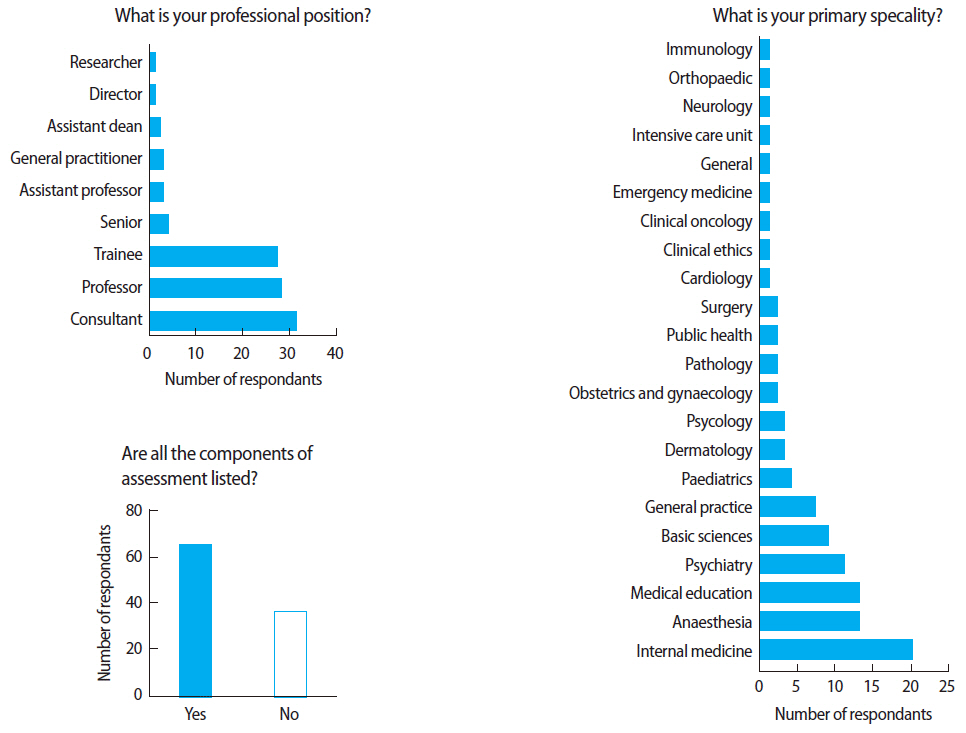J Educ Eval Health Prof.
2014;11:28. 10.3352/jeehp.2014.11.28.
What steps are necessary to create written or web-based selected-response assessments?
- Affiliations
-
- 1BMJ Onexamination, Cardiff, United Kingdom.
- 2Undergraduate Medical Education & Centre for Medical Education, McGill University, Montreal, Canada.
- 3Department of Neurology, Montreal General Hospital, McGill Centre for Medical Education, Montreal, Canada.
- 4BMJ Learning, BMA House, Tavistock Square, London, United Kingdom. kmwalsh@bmjgroup.com
- KMID: 2380947
- DOI: http://doi.org/10.3352/jeehp.2014.11.28
Abstract
- Before we work out what constitutes an assessment's value for a given cost in medical education, we must first outline the steps necessary to create an assessment, and then assign a cost to each step. In this study we undertook the first phase of this process: we sought to work out all the steps necessary to create written selected-response assessments. First, the lead author created an initial list of potential steps for developing written assessments. This was then distributed to the other three authors. These authors independently added further steps to the list. The lead author incorporated the contributions of these others and created a second draft. This process was repeated until consensus was achieved amongst the study's authors. Next, the list was shared by means of an online questionnaire with 100 healthcare professionals with experience in medical education. The results of the authors' and healthcare professionals' thoughts and feedback on the steps, needed to create written assessment, are outlined below in full. We outlined the steps that are necessary to create written or web-based selected-response assessments.
Keyword
Figure
Reference
-
1. Walsh K. Cost effectiveness in medical education. Radcliffe: Abingdon;2010.2. Walsh K, Levin H, Jaye P, Gazzard J. Cost analyses approaches in medical education: there are no simple solutions. Med Educ. 2013; 47:962–968. http://dx.doi.org/10.1111/medu.12214.
Article3. Schuwirth LW. General overview of the theories used in assessment: AMEE Guide No. 57. Med Teach. 2011; 33:783–797. http://dx.doi.org/10.3109/0142159X.2011.611022.
Article4. Norcini J, Anderson B, Bollela V, Burch V, Costa MJ, Duvivier R, Galbraith R, Hays R, Kent A, Perrott V, Roberts T. Criteria for good assessment: consensus statement and recommendations from the Ottawa 2010 Conference. Med Teach. 2011; 33:206–214. http://dx.doi.org/10.3109/0142159X.2011.551559.
Article5. Hayes K, McCrorie P. The principles and best practice of question writing for postgraduate examinations. Best Pract Res Clin Obstet Gynaecol. 2010; 24:783–794. http://dx.doi.org/10.1016/j.bpobgyn.2010.04.008.
Article6. Patricio MF, Juliao M, Fareleira F, Carneiro AV. Is the OSCE a feasible tool to assess competencies in undergraduate medical education? Med Teach. 2013; 35:503–514. http://dx.doi.org/10.31 09/0142159X.2013.774330.
- Full Text Links
- Actions
-
Cited
- CITED
-
- Close
- Share
- Similar articles
-
- Development of the Web-Based Instruction Program for Nurses: Focused on Nursing Care after Open-Heart Surgery
- Cross-platform digital assessment forms for evaluating surgical skills
- The Development and Effectiveness of a Web-based Instruction Program for Nursing Informatics
- Development Effect analysis of Web-based CIA program for Nursing: Application to Maternity Nursing
- New approach to learning medical procedures using a smartphone and the Moodle platform to facilitate assessments and written feedback


